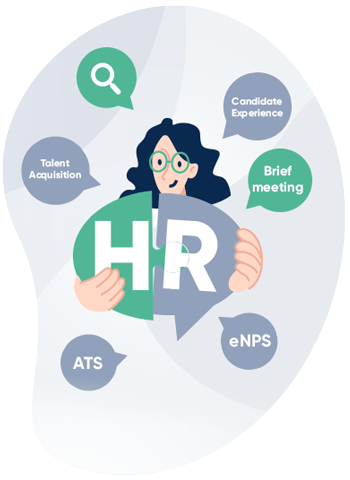Crowdstaffing, sourcing, screening, talent acquisition, RPO – what do popular HR terms mean? In this post we will try to discuss the most common terms in the HR industry.
Human resource management
In order for the company to grow, it needs the best professionals on its team! This principle applies especially to the HR department, which is responsible for one of the most important processes in the organization. Among the main ones are recruitment and onboarding, i.e. getting new employees and implementing them into the organization’s structures. HR professionals are talent scouts who are able to perfectly match a candidate to a position. They also take care to prevent employee turnover in the team.
Depending on the company, the HR department also goes by other names, such as:
- human resources department,
- Personnel,
- personnel department,
- human capital management department.
In multinational corporations it may also be called a department:
- employee success,
- human capital management,
- people operations.
More essential than the name are the people who make up the HR team and take an active role in recruiting each new candidate. Employers are increasingly opting for recruitment outsourcing, i.e. outsourcing all recruitment and even onboarding processes to an external company. Companies cooperating with Talent Place can get project-based recruitment services or hire a recruiter, e.g. part-time or full-time, to join your team under Recruitment Process Outsourcing (RPO model).
How to read job offers? Recruitment process
Candidates looking for interesting offers will encounter a lot of information that they will have to assimilate on their way. The HR industry is constantly evolving, so it’s a good idea to keep up to date with all the new concepts. It will certainly be useful for anyone who cares about advancing his or her career, and not only in the field of human resources. Let’s take a look at what are the most important concepts in the HR industry:
Crowdstaffing
That is, recruitment by a community of recruiters with broad experience in many industries. Crowdstaffing is about building a flexible community of freelancers. What’s more, recruiters from different industries work together – each can count on the support of other HR experts during recruitment. Talent Place is the first recruitment solution in Poland based 100% on the crowdstaffing.
Brief meeting
This is a short meeting at the beginning of cooperation with a recruitment company to discuss the project. During the brief meeting, the client defines their recruitment needs, expectations of the ideal candidate and allows the recruiting team to get to know their organization better. This is to prepare the HR team to effectively carry out the recruitment project.
Sourcing
That is, the process of finding new employees by searching for them online and offline. Today, this is most often done through social media. The most popular portal for performing sourcing is LinkedIn, where you can find a number of interesting people open to a new job. During this process, however, it is good to go beyond the standard schemes and open up to custom sourcing.
Screening
This is nothing more than the first stage of recruitment, i.e. the first contact with the candidate on the part of the employer. Usually it is a short telephone conversation, during which basic information is provided about the potential employee’s competence and knowledge. Very often, a date for another on-site or online meeting is then agreed upon.
Assessment Center
The employee will already be confronted with this issue during the recruitment process. It’s a method based on assessing candidates’ abilities. A dedicated specialist (assessor) observes the session and notes the strengths of the interviewee. Such meetings can take place both individually and in groups.
Talent Acquisition
Acquisition of especially gifted individuals. Weeding out those with strongly developed interpersonal skills and assessing which of them make a real contribution to the company. We are not only talking about those who have specific skills. Recruiters also ”fish out” people with an aptitude for learning new competencies quickly.
Trends in the labor market and their nomenclature
Employers looking to expand must move with the times. This principle applies to everyone, regardless of the industry they are involved in. Investment in new tools and solutions is the key to success. Every candidate, once hired, goes through the onboarding, or implementation, process. It can take place both on-site and remotely, using platforms designed for this purpose. The onboarding process can be defined in several points:
- contract signing,
- Participation in health and safety training,
- Participation in product courses to discuss customer work and familiarize with the idea of the company,
- Acclimatization in the new workplace – getting to know the staff structure and the people in each department.
Based on the various stages of onboarding, an employee journey map is prepared, a tool for checking and controlling the implementation process. Such feedback allows you to improve the hiring of new employees and streamline it as much as possible. Both suggestions from the HR department and accepted candidates are taken into account during the analysis.
Other HR terms you should know
Let’s take a look at the next important terms in our HR glossary. Issues related to the topic of recruitment can be counted in the hundreds. We, however, focused on those – in our opinion – the most important and most useful. These include:
eNPS indicator
Employee net promoter score, translated into our native language: employee loyalty index. An essential tool for employers, it allows them to gauge employee satisfaction with their work. The survey involves rating the organization on a scale of 0 to 10. The fact that the employer asks about the level of satisfaction is a definite plus, as it shows its concern and willingness to take care of the well-being of employees.
ATS (Applicant Tracking System)
A system to automate the hiring of new people. This can be done by filtering incoming resumes and storing them, as well as automatically sharing announcements and information on job vacancies.
Outplacement
A novelty in the market, used by a small number of employers. Outplacement is of great importance for the psychological well-being of employees, especially those struggling with mental health problems or lowered self-esteem. It’s a form of assistance that helps laid-off people cope with the loss of their jobs and find their way in a new situation. It can include professional psychological assistance combined with advice and guidance on next steps.
Headhunter
This is a “talent scout”, tasked with finding candidates who are most suited to the needs of a particular position and company. Currently, in some companies, headhunter and recruiter are synonymous terms.
Candidate Experience
Literally translated as “candidate experience.” This is the sum total of a candidate’s experience with a company or potential employer. They appear during recruitment and are built up subconsciously during every contact with the company.

